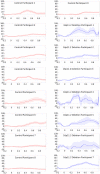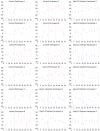Abnormal Speech Motor Control in Individuals with 16p11.2 Deletions
- PMID: 29352208
- PMCID: PMC5775320
- DOI: 10.1038/s41598-018-19751-x
Abnormal Speech Motor Control in Individuals with 16p11.2 Deletions
Abstract
Speech and motor deficits are highly prevalent (>70%) in individuals with the 600 kb BP4-BP5 16p11.2 deletion; however, the mechanisms that drive these deficits are unclear, limiting our ability to target interventions and advance treatment. This study examined fundamental aspects of speech motor control in participants with the 16p11.2 deletion. To assess capacity for control of voice, we examined how accurately and quickly subjects changed the pitch of their voice within a trial to correct for a transient perturbation of the pitch of their auditory feedback. When compared to controls, 16p11.2 deletion carriers show an over-exaggerated pitch compensation response to unpredictable mid-vocalization pitch perturbations. We also examined sensorimotor adaptation of speech by assessing how subjects learned to adapt their sustained productions of formants (speech spectral peak frequencies important for vowel identity), in response to consistent changes in their auditory feedback during vowel production. Deletion carriers show reduced sensorimotor adaptation to sustained vowel identity changes in auditory feedback. These results together suggest that 16p11.2 deletion carriers have fundamental impairments in the basic mechanisms of speech motor control and these impairments may partially explain the deficits in speech and language in these individuals.
Conflict of interest statement
The authors declare that they have no competing interests.
Figures







References
-
- Tager-Flusberg, H., Paul, R. & Lord, C. In Handbook of Autism and Pervasive Developmental Disorders, 3rd Edition (eds Volkmar, F. R., Paul, R. & Klin, A.) 335–364 (2005).
Publication types
MeSH terms
Supplementary concepts
Grants and funding
LinkOut - more resources
Full Text Sources
Other Literature Sources

